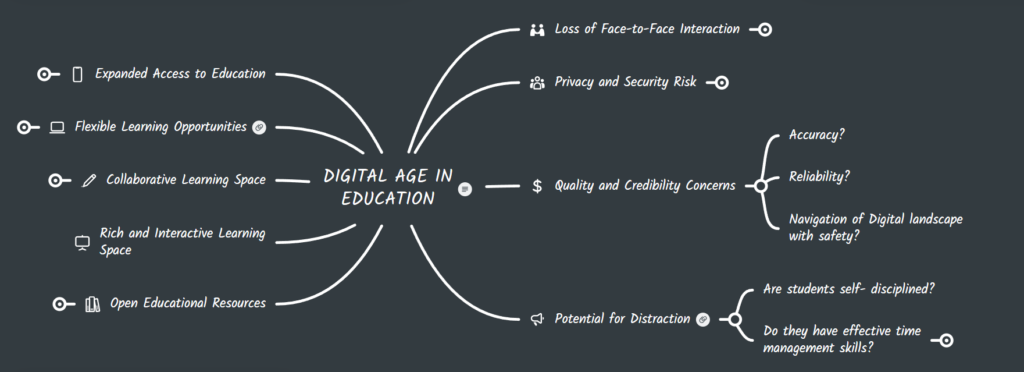“Yet our educational institutions were built largely for another age, based around an industrial rather than a digital age” (Bates, 2015, p. 15).
WHAT?
Tony Bates (2015) in chapter one of his book Teaching in a Digital Age talks about the challenges and the opportunities that the ongoing Third Industrial Revolution has resulted in. The digital revolution, which has affected all walks of life, has not failed to leave its mark on the education sector. The impact is unmistakable and evident.
There is no denying the fact that this undercurrent that is at present riding the highs of the digital age holds in itself great caliber to reform the way we teach and learn. In a world where we are constantly witnessing new innovations, where “change” is the new normal, and where “digital natives” (p.34) are always immersed and stimulated by means of social media, there is a pressing need to study the multi-faceted nature of digital media to ensure equitable and effective learning experiences.

Moreover, the lesson also necessitates the need to re-imagine assessment methods, instructional design, teaching methodologies, and student engagement to cope better with the pedagogical differences while making the shift from face-to-face to online learning to make the transition a successful learning experience.
So… What?
Well, as a result of the shift, the digital age demands a shift in the teaching paradigm, a departure from the conventional to embracing the needs in order to meet the expectations of digital learners.
Emphasizing the need to match pace, Mark Prensky (2001) highlighted how “digital natives” fundamentally think and learn in a manner that is essentially different, which makes the question, “Why should their learning experience be different?” (p.35) only more compelling.
However, the questions persist, how can a better understanding of digital learners empower educators’ pedagogical practices?
Should technology integration not be an integral part of modern-day classrooms, especially the ones that focus on skill development as “Skills development is much more tied to specific teaching approaches and technologies” (p.22)?
In a world where knowledge is constantly and rapidly evolving, how can knowledge be best managed?
Now… What?
With a wonderful analogy of pilots who would not be expected to fly modern jets without any proper training, Bates (2015) asks why teachers are expected to become tech-savvy overnight without any prior tech training. Indeed, a grueling question.
Bates (2015) expounds that by incorporating interactive digital tools and resources, teachers can leverage OERs (Open Educational Resources) and initiatives that can improve the teaching-learning discourse for our students. Nevertheless, to create more interactive and dynamically charged platforms, there is an urgent need to stay updated with technological advancements to deliver our utmost best as educators. There is also a need for educators to demonstrate readiness that promotes a lifelong learner attitude toward professional development.
All in all, it is as much a responsibility of the educator as it is of the students to exist flexibly in a “knowledge-based society” (p.24) and to gauge the demands of the labor market and also, not let these demands dictate the sole focus of education. The emphasis should ideally be on fostering skills such as critical thinking, problem-solving, creativity, adaptability, and a lifelong love for learning. Ultimately, the goal is to empower learners to navigate these ever-changing digital landscapes and make meaningful contributions to shape society’s progress, driving innovation and change for our collective future.
REFERENCES
Bates, A. (2015). Fundamental Change in Education. Teaching in a Digital Age, 1(3). http://dergipark.ulakbim.gov.tr/glokalde/article/view/5000135229
Prensky, M. (2001) Digital natives, Digital Immigrants On the Horizon Vol. 9, No. 5.
Hello Tanya, Thank you for sharing your experience about how you had to modify your plan, changing in from a…
Hello Tanya, Thank you for sharing your different learning experiences. I can relate to the sentence you wrote whereby the…
Hi Tanya! Thanks for sharing that fantastic video. It was really deep, and I enjoyed watching it. What I loved…
Hey Noah, Thank you for your comment! I often times rely on digital pedagogy in my ESL classroom. I can…
Hi Tanya, I love the activities that you provided to go along with your video, very creative! I think that…